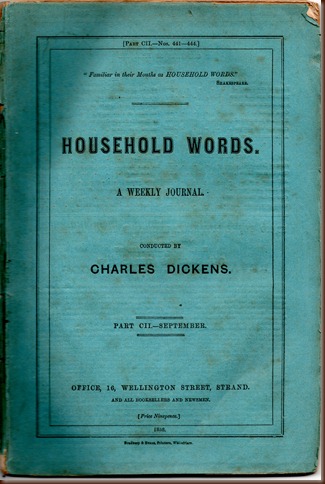
‘Household Words ‘ 1858.
Up early on this very frosty morning just as dawn was breaking over the top of the towpath hedge next to my mooring. Two dark shapes moving behind the hedge caught my eye,their outlines silhouetted against the dawn by the rays of light made me realise that they were a pair of donkeys.
For a Christian this might have been a deeply symbolic moment what with the time of year and all !.Instead my thoughts turned to the proximity of the towpath to the animals and reminded me of how once on certain canals these donkeys would have lived a very different life.
No such romantic thoughts would have passed through Captain Randle’s mind when he left London on board the fly boat ‘Stourport’ in the early hours of an August day in 1858. Instead I feel sure that he would have been preoccupied with thoughts of the unusual cargo he was carrying and although he didn’t know it, Captain Randle was about to make a little bit of Canal history.
For the ‘Stourport’ belonging to the Grand Junction Canal Carrying Co was that morning carrying, apart from the usual various boxes, barrels and packets destined for various up-country wharfs, a journalist and his friend together with a large meat pie brought along for sustenance on their journey to Birmingham.
John Hollingshead was a freelance journalist writing for Charles Dicken’s topical magazine ‘Household Words’. This magazine had been founded by Dickens in 1850 who used it to express his social concerns. Priced at only 2d it was nevertheless aimed at concentrating the minds of a predominantly middle class audience towards the evils of poverty,working class housing and (with the River Thames at that time an open sewer) the sanitation of the metropolis. To popularize the magazine Dickens found he had to include more popular subjects such as travel and in particular serialized fiction. Some of his first novels and those of Wilkie Collins first saw the light of day here.
Hollingshead had previously written on the state of the gipsy population and had lived with and reported on the railway navvy gangs before now turning his attention to Britain’s floating population on the canals.

Title heading of First part of ‘On The Canal’’ Saturday September 11th 1858.
That Holingshead wrote this article at this particular time is a fact that all succeeding generations of canal lovers, historians and in particular students of popular British Folk Art have reason to be grateful for because it is generally recognized to be the first detailed written account of canal boat life in the UK. The boaters and their life,dress,food,social habits as well as a description of the boat are all given in some detail. Although it has to be remembered that this was a fly boat with an all male crew of 4 travelling night and day that is being described and not a ‘family boat’.
‘The Stourport is rather faded in its decorations,and is not a gay specimen of the fly-barge in all its glory of cabin paint and varnish; but still enough remains to show what it was in its younger days,and what will be again when it gets a week in dock for repairs in Birmingham. The boatman lavishes all his taste; all his rude,uncultivated love for the fine arts upon the external and internal ornaments of his floating home. His chosen colours are red,yellow and blue; ………….The two sides of the cabin,seen from the bank and the towing path, present a couple of landscapes in which there is a lake,a castle,a sailing boat and a range of mountains painted after the style of the great teaboard style of art.
It is the underlined portion of the above quote from the article that has excited the most interest over the years as it is as far as is known the very first indication of the existence of the now famous ‘rose and castle’ decoration on the boats. What a pity that this article like all the others in the magazine was unillustrated. We have to wait until 1873 for this.
Hollingshead goes on to describe the painted water can and amongst other topics he gives details of – the boaters clothing and habits,diet,living quarters and possessions are all described in some detail. The journey and people encountered are discussed and most illuminating of all, some brief chats with the boaters are given.
The article takes up some 17 pages spread over 3 consecutive issues – those for 11th Sept, 18th Sept and 25th Sept 1858.
Hollingshead’s article like all those in ‘Household Words’ is unattributed and we would not have known of his authorship but for the fact that a paybook has survived listing all contributors and their articles.
The author went on to theatre management and became quite a famous music hall promoter and manager bringing Gilbert & Sullivan together for the first time and presenting their first operetta.
If you want to read the whole article – the Waterways Museum brought out a copy in thin card covers in 1973. Otherwise the Dickens Journals Online has down loaded the whole of the 9 years of production of the mag and you should be able to sort out the relevant issues. Try http://www.archive.org/details/djo . Go to Vol 18 and the start pages are 289,318 & 354.
2 comments:
Hello Mick, I'm hoping to publish a sketch of 'Amos Reade', can I use your book cover images in my project? As you are aware, a very rare title.
Sorry for the long delay in replying but yes sure go ahead.Would love to see your sketch when published.
Post a Comment